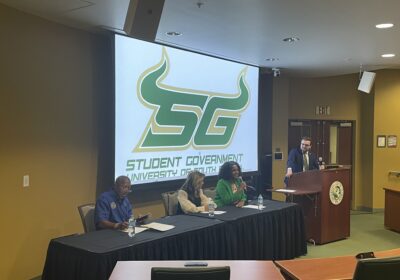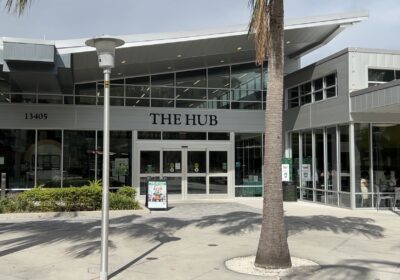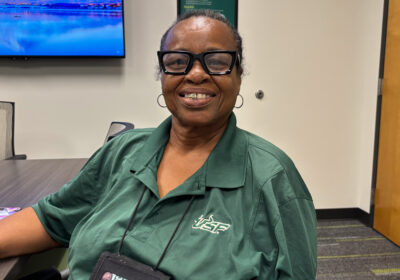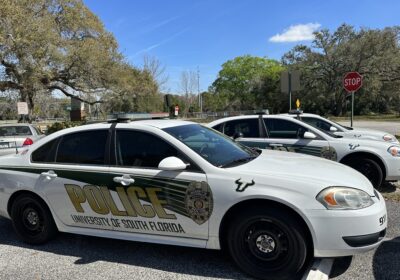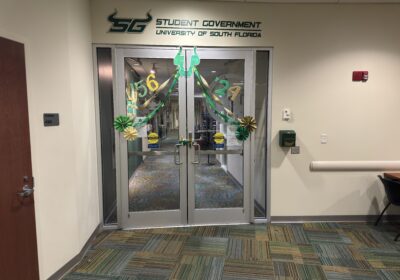Faculty weigh different teaching methods, COVID-19 concerns heading into fall

As the fall semester grows closer, faculty members like Scott Perry, a history professor at the Sarasota-Manatee campus, are hoping to integrate virtual instruction with the proposed return to on-campus activity outlined by USF administration.
“I’m one of those people who felt that the hybrid model was a really smart one. I find it really exciting to be able to do a combination of things, and the best thing about teaching this way is I have a few students in the classroom and then I have students that participate through [Microsoft] Teams, and they really participate,” he said.
“They either unmute themselves and they contribute to discussion, or when I’m lecturing they put comments and questions in the chat … I think particularly for students who are shy about speaking in class, the chat function is magnificent. My ideal [method of teaching] for the fall would be to continue with something like the hybrid model.”
In a universitywide email March 3, USF President Steven Currall announced that the university would be returning to “pre-COVID operations” reminiscent of fall 2019 as soon as the Summer B semester, in accordance with guidance from public health and infectious disease experts.
Professor at the St. Pete school of marketing and innovation Stephen Diasio is “apprehensive” about returning to a traditional teaching style in the fall because he has seen his students excel in an online format.
“I feel that my work and what I do in my classes and my content is running at peak level with online delivery. That being said, there’s something renewing about being with others, face to face in a group setting, so that’s something exciting,” he said.
“However, there is some apprehension about what that looks like in terms of this new normal. Hopefully we’re not going back to teaching like in the past.”
Diasio said returning to the traditional style of in-person classes would be a “regression,” as he has seen his students become more “innovative” and “entrepreneurial” now that they have the freedom to attend school and travel at the same time. The decision by administration to resume in-person activity, he said, could end that freedom.
“There seems to be a constant flux of information and decision making. I don’t know where it happens, but somewhere in the ether, people make decisions [about the fall semester],” he said.
“My hope is to continue this momentum and not lose the opportunities and value that we’ve created for our students, and not to regress to teaching of these somehow single-room classroom style, 16-week educational models, but reinventing and creating opportunities because of this crisis that has opened our eyes to new ways of educating.”
While most faculty members agree the hybrid method is ideal, some feel that even a partially in-person class is too risky because of the unpredictability of the virus and the potential for the emergence of new variants.
Darlene DeMarie, professor of educational psychology at the Sarasota-Manatee campus to doctoral students, said the “pluses outweigh the minuses” for online graduate work and she wishes she could continue teaching synchronously as she has this year.
“I was told I had no choice, all of our classes will be in person [in the fall]. Although I prefer teaching in person, I have learned a great deal from teaching synchronously online that I will bring back to my face-to-face teaching,” she said.
“My only concern is whether we will have the virus behind us by then. I fear the variants will develop from people’s casual attitudes.”
Several faculty members, like DeMarie, have expressed apprehension about having a full capacity classroom within the next few months. In an interview with The Oracle earlier this month, Provost Ralph Wilcox said if pandemic conditions continue to allow for full class capacity in the fall, faculty members would need to submit an ADA accommodation request through the Human Resources department if they wish to continue teaching their courses online.
For many professors, however, the method of preference is a return to face-to-face instruction. Joshua Gamsby, assistant professor in the department of molecular medicine at USF Health, said he’s ready to teach in person.
“I am eager to return to campus and resume normal academic activities with my students,” Gamsby said. “Like many of us, I miss the daily interactions with my students and colleagues.”
His newest idea is bringing Microsoft Teams to the classroom so students are able to share their screens with each other during question and answer sessions to help each other understand the material.
Arash Takshi, assistant professor in the department of electrical engineering at the Tampa campus, also found that there are benefits to the ways students and professors have adapted to the constraints of the pandemic. Takshi began consulting with each of his students on a one-on-one basis for an hour each week over Microsoft Teams to evaluate their individual progress.
“A couple of weeks after I started [individual online meetings], I learned that students need me to check on them to see what their own specific mistakes on each exam are,” he said. “If someone can point out exactly what mistake they made, they learn better.
“This is something that we have never done before. In the past, before the pandemic, we gave lectures, quizzes and exams and then later just posted the grades and the solutions, but there was never a good sort of feedback to every individual student to help them with the work. It might not be a very feasible approach to keep it like that, but I certainly would like to try my best to have something like that when the pandemic is over.”
While the majority of professors enjoy the hybrid model, professor of psychology on the Tampa campus Judith Bryant feels she is “old-fashioned” because she prefers in-person lectures and the ability to pace around the classroom while she teaches.
“I’ve been [back in my office] as soon as we were allowed to be here. I’ve got better technology, it’s quiet, I’ve got good internet and every now and then I bump into somebody who happens to be here,” she said.
“I tend not to use PowerPoint [when teaching], it’s way too linear. I use big expanses of whiteboard and I draw out concept maps and do all kinds of stuff so that I can go across multiple boards with different color markers and so on. Since I teach mostly about child development I can demonstrate things, as opposed to just sitting here with [my computer].”
Being able to see students and colleagues again is a welcomed aspect of returning to campus for many professors who have been missing that human interaction.
Nicole Stowell, professor of business law at the St. Pete campus, is cautiously optimistic about returning to campus in the fall. Though she has found success using the hybrid model, teaching six students in person and the rest of her class virtually, she misses the camaraderie that a bustling campus brings.
“It’s just so sad to see all the empty buildings and empty classrooms, so I’m hoping that we’ll be back to some resemblance of normalcy in the fall and I will see students in the College of Business and the atrium because now there’s just no one,” she said.
During her day-to-day life on campus, Stowell said she missed getting to hold meetings for the Pre-Law society of which she is the adviser. She even missed seeing things like chalk drawings on the sidewalks to announce events.
Despite missing normal activity, Stowell said she has adapted well to the challenges posed by the pandemic, but she is worried that many students have not. She said that getting students back to campus will reinvigorate the social skills that many, including herself, have seen diminish over the past year.
“I was walking into the restroom at the College of Business the other day, and of course there was no one there. So I was walking in and someone was walking out and I flinched,” she said. “We got a laugh out of it, but its [social skills] like that we have lost.”
The resumption of social interactions is a concern for associate professor of psychology Max Owens. Even though he has completed his series of vaccine doses, he fears students are not comfortable coming back.
“I feel OK teaching in person during the fall, but I am aware some students may not feel the same way,” he said. “If the students and university feel it is best to remain online during the fall I am prepared to teach online or hybrid if necessary with the online materials I have created during the pandemic.”
Though he is ready to return to in-person teaching, Faculty Senate President Timothy Boaz has found that faculty overall have had mixed views on returning to campus.
“There’s been quite a bit of concern,” he said. “But I think most people kind of have the same view of this that I do, that our administration’s been a little on the conservative side compared to other universities, but that they did the right thing because we’ve had terrific [low] numbers [of coronavirus cases] at USF.
“I think faculty have been concerned about going back into the classroom, but I’ll just say there’s a lot of enthusiasm for getting back to class and getting back into our offices.”
Given the unpredictable nature of the virus, faculty are remaining resilient and preparing for whatever instruction methods the future may hold.
“There are some things that we’ll just have to wait and see how they turn out, but you just have to take it in stride,” Stowell said. “I think we’re turning the corner and I’m hoping the light at the end of the tunnel is getting brighter.”

